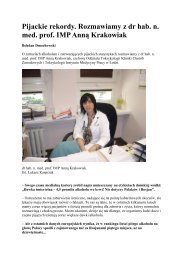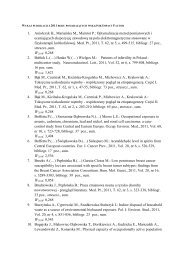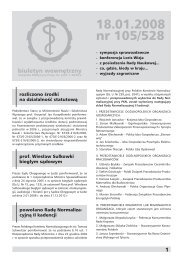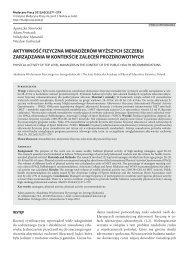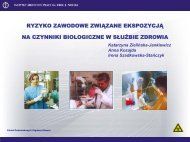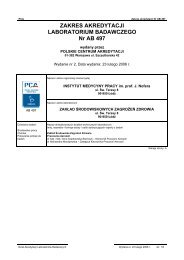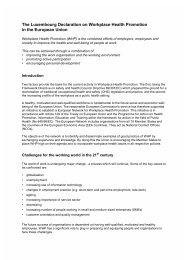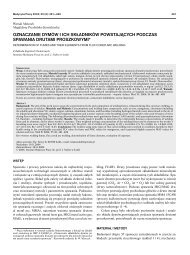taste and smell perception among sewage treatment and landfill ...
taste and smell perception among sewage treatment and landfill ...
taste and smell perception among sewage treatment and landfill ...
You also want an ePaper? Increase the reach of your titles
YUMPU automatically turns print PDFs into web optimized ePapers that Google loves.
TASTE AND SMELL PERCEPTION AMONG SEWAGE WORKERSORIGINAL PAPERScould serve as indicators that would help detect the hazards<strong>and</strong> enhance systematic monitoring of the functionsof sense organs. Performing these tests on workers occupationallyexposed to harmful agents provides an opportunityfor assessment of the compensatory ability of boththe sense organs [26].Own experience in investigating the sensory dysfunctionsprompts a complex nature of the causes of dysfunctionsreported in the present study. Presumably, a dysfunctiontakes place at several stages of the reception of thesense stimulus. It is plausible that even the first stagei.e. reaching the receptor by stimulus, can be hinderedby a mechanical barrier, namely oedema of the mucousmembrane irritated by airborne particulates. The processof dissolving chemical stimulus in the mucus layeroften becomes abnormal because of the changes in themucus composition that result from occupational exposure.This leads to a decrease in the connection betweenthe stimulus <strong>and</strong> the receptor. The functions ofthe gustatory <strong>and</strong> olfactory receptors, which are directlyexposed to toxic agents, could also be considered. Thereis a hypothesis that the sensory neuroepithelium is sensitiveto environmental exposure to pollutants [27–29].Finally, the changes can also relate to further parts ofthe sensory tract.The knowledge about the influence of long-term exposureto chemical hazards on the senses of <strong>smell</strong> <strong>and</strong> <strong>taste</strong>is inadequate. Occupational dysfunctions of the <strong>smell</strong> <strong>and</strong><strong>taste</strong> are usually subclinical <strong>and</strong> can often be found onlyduring the olfactometric <strong>and</strong> gustometric examinations.Therefore, the findings presented above show a need fora further research in this area.CONCLUSIONThe gustometry <strong>and</strong> olfactometry results indicate a higherrisk of <strong>smell</strong> <strong>and</strong> <strong>taste</strong> dysfunctions <strong>among</strong> <strong>sewage</strong> <strong>treatment</strong><strong>and</strong> l<strong>and</strong>fill workers. The sense of the sour <strong>taste</strong> appearedto be most sensitive after short-term exposure, butthis dysfunction is probably reversible in nature. The other<strong>taste</strong>s were found to be more sensitive to chronic toxicexposure than the sour <strong>taste</strong>. Occupational dysfunctionof the senses is usually multicausal <strong>and</strong> subclinical in nature.It can often be found exclusively during professionalexaminations.REFERENCES1. Kuszmider G, Mrowiec B, Kubiesa I, Suschka J. The gasiformorganic substances emission to atmosphere from sludge. ArchOchr Środ 1997;23:79–90 [in Polish].2. Lemasters GK, Zenick H, Hertzberg V, Hansen K, Clark S.Fertility of workers chronically exposed to chemically contaminatedsewer wastes. Reprod Toxicol 1991;5:31–7.3. Thornton I, Butler D, Docx P, Hession M, Makropoulos Ch,McMullen M, et al. Pollutants in urban waste water <strong>and</strong> <strong>sewage</strong>sludge. In: European Communities ICON, IC ConsultantsLtd, editors. Final Report. London: Office for OfficialPublications of the European Communities; 2001. p. 1–19.4. Cyprowski M, Krajewski JA. Harmful agents in municipal wastewater<strong>treatment</strong> plants. Med Pr 2003;54(1):73–80 [in Polish].5. Laitinen S, Kangas J, Kotimaa M, Liesivuori J, MartikainenPJ, Nevalainen A, et al. Workers’ exposure to airborne bacteria<strong>and</strong> endotoxins at industrial wastewater <strong>treatment</strong> plants.Am Ind Hyg Assoc J 1994;55(11):1055–60.6. Thorn J, Beijer L, Jonsson T, Ryl<strong>and</strong>er R. Measurement strategiesfor the determination of airborne bacterial endotoxin in<strong>sewage</strong> <strong>treatment</strong> plants. Ann Occup Hyg 2002;46(6):549–54.7. Prażmo Z, Krysińska-Traczyk E, Skórska C, Sitkowska J, CholewaG, Dutkiewicz J. Exposure to bioaerosols in a municipal <strong>sewage</strong><strong>treatment</strong> plant. Ann Agric Environ Med 2003;10:241–8.8. Wlazło A, Pastuszka JS, Łudzeń-Izbińska B. Assessment ofworkers’ exposure to airborne bacteria at a small wastewater<strong>treatment</strong> plant. Med Pr 2002;53:109–14 [in Polish].9. Krajewski JA, Cyprowski M, Szymczak W, Gruchała J.Heath complaints from workplace exposure to bioaerosols:a questionnaire study in <strong>sewage</strong> workers. Ann Agric EnvironMed 2004;11:199–204.10. Scarlett-Kranz JM, Babish JG, Strickl<strong>and</strong> D, Lisk DJ. Health<strong>among</strong> municipal <strong>sewage</strong> <strong>and</strong> water <strong>treatment</strong> workers. ToxicolInd Health 1987;3(3):311–19.11. Thorn J, Kerekes E. Health effects <strong>among</strong> employees in<strong>sewage</strong> <strong>treatment</strong> plants: A literature survey. Am J IndMed 2001;40:170–9.IJOMEH 2009;22(3) 233



